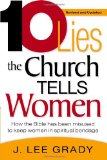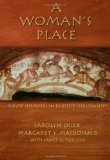This is for the Day 2 Challenge, Write a List Post, for 31 Days to Build a Better Blog Challenge at The SITS Girls on BlogFrog.
For my list post(s) I have decided to give the 10 books that empowered me to be the woman and leader that Godde called me to be. This is the first post of two. I will post the second part including theology and worship books tomorrow.
Practical Books
All We’re Meant to Be: Biblical Feminism for Today by Letha Scanzoni and Nancy Hardesty
This book was instrumental in helping me claim my life as my own as a leader in the church and as a single woman who didn’t know if she wanted to get married and have kids. I did get married, but I chose not to have children for the simple reason I am not called to be a mother (and The Hubby is just fine with being Uncle Tracy, thank Godde). This book gave me that option as a Christian woman. Scanzoni and Hardesty systematically take the reader through the Bible pointing out where mistranslations, mis-interpretations, and neglect have been used to caricature the women of the Bible as wives and mothers and nothing else. They lay solid biblical and theological groundwork for why women were created to be more than wives and mothers (without diminishing those roles: they are important!), and they illustrate how women were merchants, business women, spiritual and political leaders in The Hebrew Scriptures and The New Testament.
Ten Lies The Church Tells Women by J. Lee Grady
 Grady, the former editor and now contributing editor for Charisma Magazine, systematically goes through the lies that most women grew up with in church:
Grady, the former editor and now contributing editor for Charisma Magazine, systematically goes through the lies that most women grew up with in church:
-
-
-
- God created women as inferior beings destined to serve their husbands.
- A woman should view her husband as the “priest of the home.”
- Women who exhibit strong leadership qualities pose a serious danger to the church.
- Women can’t be fulfilled or spiritually effective without a husband and children.
- Women shouldn’t work outside the home.
-
-
Grady goes through each lie telling how he has seen it effect women in many churches through the years, and giving women solid, conservative, biblical positions to stand on if and when Godde calls them to be leaders in their church or calls them to a secular vocation outside of the home. If you’re on the conservative side this is the book I recommend you start with. Grady has a high regard for the inerrancy of the Bible, and conservative women won’t feel like he is manipulating Scripture or putting traditions and world cultures ahead of the Bible.
Harlot by the Side of the Road by Jonathan Kirsch
 This is one of my all-time favorite books, period. This book began when Kirsch, a Jew, decided to start reading The Hebrew Scriptures to his son at bedtime. He was amazed at the stories they hit not too far into Genesis: a drunk and naked Noah. He went on to discover adultery, gang rape, incest, and war. He didn’t remember any of this from when he learned the stories as a child, so he began investigating the forbidden tales of the Bible and out came this wonderful book. These are the stories that all of us who claim The First Testament as our holy scriptures want to leave out. Here are a few of the chapter titles to give you an idea of the forbidden tales he uncovers:
This is one of my all-time favorite books, period. This book began when Kirsch, a Jew, decided to start reading The Hebrew Scriptures to his son at bedtime. He was amazed at the stories they hit not too far into Genesis: a drunk and naked Noah. He went on to discover adultery, gang rape, incest, and war. He didn’t remember any of this from when he learned the stories as a child, so he began investigating the forbidden tales of the Bible and out came this wonderful book. These are the stories that all of us who claim The First Testament as our holy scriptures want to leave out. Here are a few of the chapter titles to give you an idea of the forbidden tales he uncovers:
- Life Against Death: The Sacred Incest of Lot’s Daughters
- The Woman Who Willed Herself into History: Tamar as the Harlot by the Side of the Road
- The Bridegroom of Blood: Zipporah as the Goddess-Rescuer of Moses
- God and Gyno-sadism: Heroines and Martyrs in the Book of Judges
This well researched book is very accessible to readers who are not scholars and theologians. Kirsch helps us see some of the women in the Bible who have been considered as sexually loose or whores in a new light. He also helps us to see how we, as people of The Book, can start navigate the abuse and violence of our world in a biblical context.
History
Women’s Work: The First 20,000 Years Women, Cloth, and Society in Early Times by Elizabeth Wayland Barber
 Here’s what people don’t realize about women working and financially supporting their families: women’s work drove the ancient economy. Women’s work, weaving and textiles, fueled the ancient economy of trading. The money women made from their looms was their own to manage how they saw fit. Women have always worked to support their families. It’s just in the first 20,000 years almost everyone worked from home (with the exceptions of soldiers and traders). Men used to work from home to support families too up until Industrial Age divided work and home into two separate spheres. Wayland Barber shows how women’s work made trade and ancient economy go round. I found the history and her research fascinating. It is also a very accessible book: you don’t have to have a specialized vocabulary or a degree in history to read this book. Here are two of my favorite excerpts.
Here’s what people don’t realize about women working and financially supporting their families: women’s work drove the ancient economy. Women’s work, weaving and textiles, fueled the ancient economy of trading. The money women made from their looms was their own to manage how they saw fit. Women have always worked to support their families. It’s just in the first 20,000 years almost everyone worked from home (with the exceptions of soldiers and traders). Men used to work from home to support families too up until Industrial Age divided work and home into two separate spheres. Wayland Barber shows how women’s work made trade and ancient economy go round. I found the history and her research fascinating. It is also a very accessible book: you don’t have to have a specialized vocabulary or a degree in history to read this book. Here are two of my favorite excerpts.
We also have many letters that the traders’ wives wrote to them from far away in Ashur, the capital of Assyria [Syria]–letters not just about how the family was getting along, but also about business matters. For at least some of the wives, daughters, and sisters were in business for themselves, acting as textile suppliers to their menfolk six hundred miles away in Anatolia [Turkey] and taking considerable profit therefrom to use for their own purposes (p. 169).
In the early layers of the Late Bronze Age sites in Israel…we suddenly begin to find locally made clay imitations of Egyptian fiber-wetting bowls, developed for just this purpose [splicing and twining linen]. The appearance of these humble textile tools, used only by women, alerts us that this is a time when women had just arrived in Palestine from Egypt in considerable numbers and settled there–and there is no other such time that we have found. Thus out of the several points in Egyptian history that scholars gave suggested for the date of the Exodus, the women’s artifacts tell us that this one (around 1500 to 1450 B. C.) is the archaelologically (sic) most probable layer to equate with their Exodus from Egypt (p. 254).
A Woman’s Place: House Churches In Earliest Christianity by Carolyn Osiek, Margaret Y. MacDonald with Janet H. Tulloch
 This is a more scholarly book but well worth the time it takes to read. Osiek, et. al. unearth the structures of ancient households and the churches meeting within them during the first 300 years of Chrisitianity before the Christian religion was legalized and churches began to be built. One of the reasons given that women should not be pastors and bishops is that a woman’s sphere of influence should be the home. But the early churches met in homes where the matriarch of the family ruled. The authors show how much responsibility women had within in their homes and how much power they wielded within their homes, which translates into women having power within the churches that met in their homes.
This is a more scholarly book but well worth the time it takes to read. Osiek, et. al. unearth the structures of ancient households and the churches meeting within them during the first 300 years of Chrisitianity before the Christian religion was legalized and churches began to be built. One of the reasons given that women should not be pastors and bishops is that a woman’s sphere of influence should be the home. But the early churches met in homes where the matriarch of the family ruled. The authors show how much responsibility women had within in their homes and how much power they wielded within their homes, which translates into women having power within the churches that met in their homes.
All book links are affliate links.
Thank you to Elizabeth Ferree at The Life of a Home Mom for giving me the idea for this list post! (She’s @homemom3 on Twitter.) Actually I took two of her ideas for a list post and crunched them together, and it got me excited to write this post. This is a first time in a long time I’ve been excited about writing a post. Thank you Elizabeth! And thank you to The SITS Girls for putting together the blog challenge, so we can encourage and inspire each other!
Thanks for stopping by LaVonne: there’s always room for one more. 🙂
Hello! Just visiting from 31DBBB. I noticed that another LaVonne stopped by too. 🙂 Amazing! A great list post. You put a lot of effort into it (Both part 1 and 2). Thanks for sharing.
Blessings and enjoy your Sunday evening!
@Tonya It’s a really interesting book, and I think it should be on every Christian woman’s shelf. Also you spell you name the same as my niece. You don’t often see Tonya spelled with the o. Cool.
The book, 10 Lies the Church Tells Women, sounds pretty interesting!
Pingback: Empowering Women: My 10 Favorite Books, Part 2 » Shawna R. B. Atteberry
Great post, obviously well thought out – unlike my list post 😀
You have an interesting blog here. Although I was raised in a Christian home, I don’t usually visit religion blogs. I like yours, it is thought provoking and clearly full of passion.
Thank you Peg and LaVonne! I’m glad it’s just what you’re looking for and confirms that I need to be writing what I’m writing about and not second guessing myself all the time.
Where have you been all my life Shawna?! Really. This is information I never even thought existed — and it does my reader’s heart good to have this list of yours and your feedback to go from. Thank you!
Ooh, these sound fascinating, thank you!